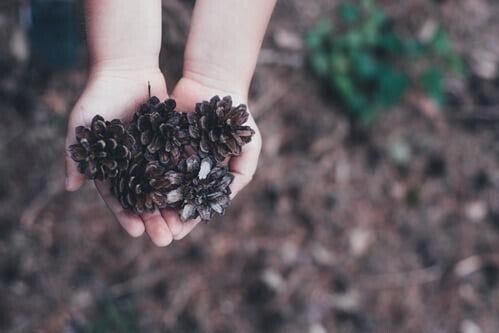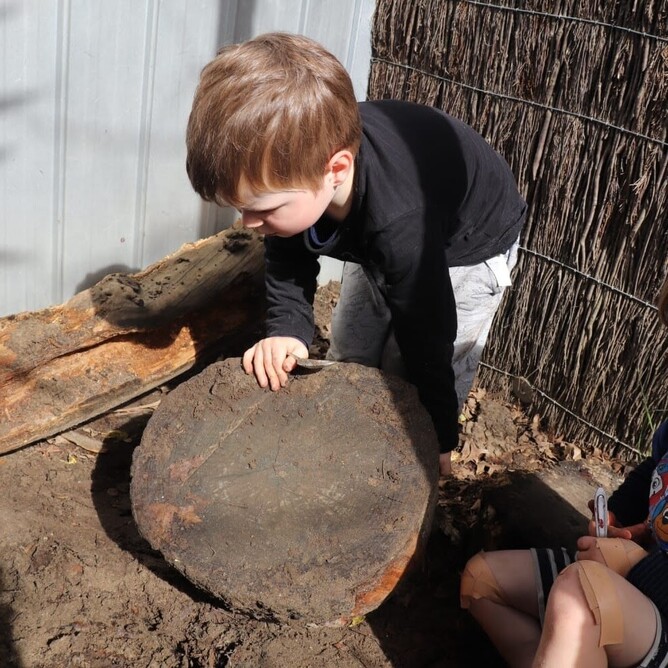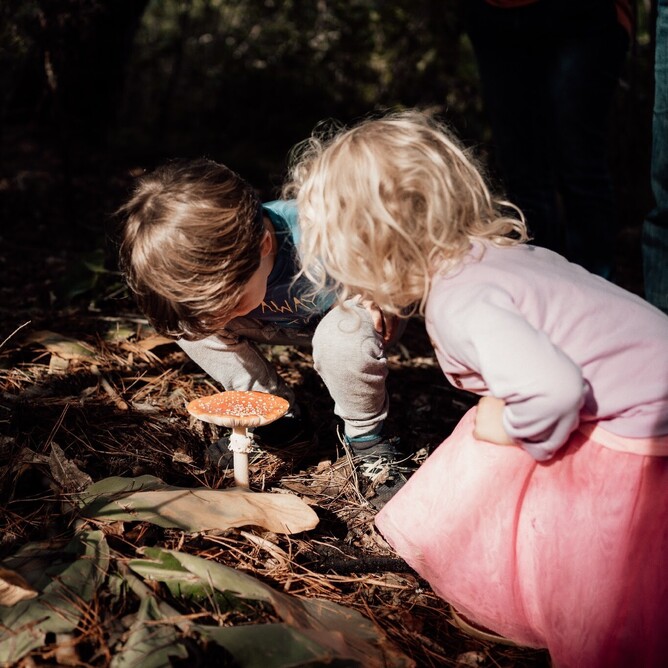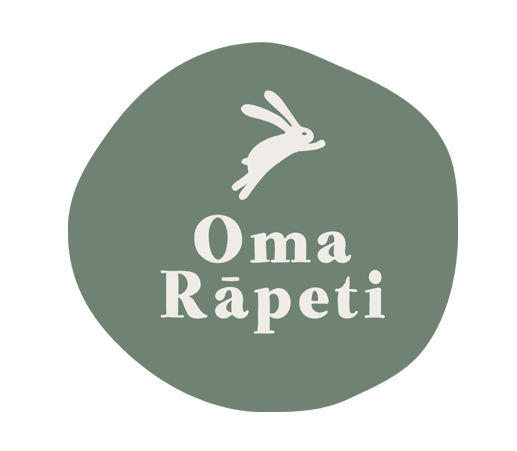Embrace the magic of heuristic play.
Summer is knocking on our door, and with that comes Christmas time.
As parents, we’re likely to be spending considerably more time outdoors over the next few months, and many of us will have gift ideas floating around our minds.
We can make the most of this outside time - and gift ideas - by embracing the magic of heuristic play. A natural, sustainable and affordable way of play and learning, with endless options for your tamariki.
It’s a favourite here at Oma Rāpeti, especially with the younger children, but it doesn’t need to stay in the childcare environment. Let us share our knowledge, so that you can make the most of outdoor exploration with your whānau.
Open-ended, limitless learning
While ‘heuristic play’ is a term we know and love as educators, it’s often not common language for parents. It’s something Elinor Goldschmied came up with in the 80’s, derived from the Greek word “Heurisko” meaning ‘serves to discover or reach understanding of’ (Goldschmied and Jackson, 1994).
That makes a lot of sense, as the essence of heuristic play is open-ended play and discovery, which takes place at each child's own individual rate.
We take natural, simple and household resources and offer them to our tamariki in calm and inviting environments. The children can select the items and explore with them at their own rate - infants will be inclined to spend time absorbing the sensory aspect of the objects. As the children get older, they may experiment with sounds, stacking, or pretend play.
This type of play provides so many options for both play and learning, going beyond the colourful and noisy repetition offered by many toys on today’s market.
The best thing - heuristic play doesn’t cost thousands of dollars, can be completely sustainable, and can be set up in any environment - even outside.
|Pronounced “hyuor·ri·stuhk”, heuristic play is a wondrous learning experience for all children.
Ways to play when you’re heading away
Summer means warmer weather, lots of outdoor play, and potentially some family getaways. You don’t have to load up the car with all your old kitchen utensils, though.
We’re blessed to be surrounded by countless incredible natural resources in our natural environment.
Going Bush?
If you’re headed on tramps, forest walks or camping off-grid, you’ll find options galore right underneath your feet.
When you’re stopped for a picnic lunch, or setting up camp for the evening, a quick scavenger hunt will likely find you everything you need for a magical treasure basket. Kindergarten aged children will love joining in as you look for resources!
You could consider gathering:
- Pebbles and Stones (age-appropriate - it’s probably best to leave these out of reach of small infants who are exploring and learning with their mouths, but older toddlers and young children will enjoy stacking and posting them)
- Pinecones
- Sticks, bark and small branches - with different textures to explore. While younger children will be able to enjoy the sensory aspect, you may notice your toddlers or kindergarteners building with sticks, or sticking them into the ground!
- A range of different leaves
- While you may instantly picture pegs, honey dippers and scarves when thinking of treasure boxes, there are loads of awesome options floating about in the great outdoors.
Water Babies
Here in Aotearoa we’re truly spoilt for choice with beautiful beach, lake and river locations. Families flock to these hotspots in the summer months, and again there are heuristic play opportunities aplenty in these environments!
Water safety is paramount, so please ensure you consider your child’s understanding and capabilities, and closely supervise any activities involving or close to water.
Smooth and gnarly pieces of driftwood, shells and naturally polished river stones make wonderful exploratory tools for little hands. Add leaves, grass, and some resources of your own and sit back while your littlies explore.
You’re also opening up doors for communication, and building vocabulary: Does it float? What noise occurs when this item is dropped into the water? How does a splash feel?
Some tips...
It can be hard to break the habit of correcting children’s play, but the beauty of heuristic play is that children take it at their own pace. So while that old rolling pin you passed to them might not be being rolled per se, if you pause and observe, you’ll notice your tamariki beginning to make sense of the world around them in their own way.
Keeping it local
Maybe your “great outdoors” is simply your backyard, or the local park or playground.
That’s awesome too! It can be easier to add some of your own heuristic play resources amongst the outdoor treasures to create magical experiences for your whānau.
Muslin cloths or wraps are great to add texture - or shade. Perhaps your toddler would like to experiment with putting items down the slide? What can you find in your backyard?
Sustainable Learning
One of the beautiful aspects of heuristic play is sustainability. Whether you’re utilising objects you’ve already got in your home, making the most of natural resources or consciously purchasing items with multiple uses, you can be assured heuristic play is kind to our earth.
If you’re a bit lost as to what you could use to put together your treasure box, we put together this handy little blog on upcycling loose parts - check it out.
Most of the resources you’ll find or create can easily be used in or outdoors, so don’t be afraid to take your magic little box of bits on your next family picnic and see what wonder your children can create!
Heuristic treasure boxes also make for gorgeous, conscious gifting as we approach the silly season. Easy on the pocket, and exciting for the children receiving them!
Wonder for all ages of young children
It’s easy to say “Hey, make the most of natural and sustainable resources, your children will learn from it”. But what exactly are they learning, and when should you start offering this kind of play?
For Infants
Heuristic play is best for infants once they are mobile to a degree. They’re likely to touch, move and mouth many of the resources offered. This is where we need to be especially mindful in the outdoor environment - close supervision is a must, and wash any objects before setting out an invitation to play if need be.
An ultimate invitation to explore, handling such objects truly helps these little people begin to make sense of their world.
For Toddlers
Around 1 - 2 years of age, toddlers are beginning to experiment with cause and effect, and you may notice they engage with this play very differently than they had, say, six months prior.
In many cases, this age brings added mobility, communicative and physical capabilities also.
Toddlers may begin to combine available resources as they develop their own working theories.
Trust your child’s competence and capabilities, and do your best not to interfere - we’re big on this at Oma Rāpeti, as is reflected in our philosophy statement.
For Young Children
Remembering that our role in heuristic play is generally to observe and let our children take the lead, you might find that kindergarten-age children want to tell you all about their findings, or ask many questions to make sense of their discoveries.
This is as interesting as it is exciting! See how you can foster their ideas and scaffold their learning by encouraging children to apply knowledge they already have.
This age group may be interested in sourcing their own resources, particularly in the outdoor environment! Ask lots of questions - What happens if…?
Exploring the great outdoors - at their pace.
Real-world resources provide real-world experiences.
Let your children take the lead in their learning, exploring the bountiful resources you have readily available. From your backyard to the beach, there are limitless learning experiences available at your fingertips everywhere you look.
As children explore these resources in their own way, at their own pace, they’re learning all about how the world works - knowledge they can apply over and over again as they grow.
We love to offer heuristic play here at Oma Rāpeti! It’s a strong and underpinning value of ours to provide children with an environment that will foster their ongoing exploration of their world.
We implore you to go out with those sticks, flora, fauna, sand and beyond, and enjoy the absolute magic that is watching your children learn. You know how you fill the playroom with toys, but they still choose the yoghurt pot? Make the most of that!
Stay tuned with our Facebook page and share your outdoor experiences with us - we’d love to hear what your tamariki enjoyed!
Aroha nui,
The Oma Rāpeti Team x




